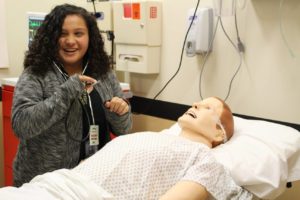Above: Ciera Coronado of Merced High School prepares to measure the pulse of a fellow student during an equipment training at Merced College. Organized by Central Valley Health Network, the event drew more than 300 local high school students interested in careers in the medical field. (Photo by Hannah Esqueda)
By Hannah Esqueda
MERCED, Calif. — While recent efforts to expand healthcare coverage to undocumented residents in Merced County saw a severe setback this week, the continued focus on current health systems has helped highlight another limitation which could soon negatively affect all patient populations.
Since the expansion of Medi-Cal in 2014, more than 30,000 residents have gained access to previously unavailable care in the county. This spike in patient population is so far unmatched in the local healthcare workforce, and the region currently has a ratio of 45.4 primary care physicians for every 100,000 residents. This falls short of the benchmark set by California law for managed care plans, which calls for at least 50 primary care physicians per 100,000 residents.
Merced County’s high Medi-Cal population–nearly one in two residents qualify for the subsidized health plan– is a deterrent for physicians as they are reimbursed at lower rates compared to private plans. Labor market data from the state’s Employment Development Department shows the region is in need of a variety of health care professionals, including registered nurses and personal care aides.
As a result, many local health leaders are increasingly looking to the high school and college level in hopes of inspiring the next generation of Merced residents to address the health care shortage.
One major step towards this goal came last week, when more than 300 high school students from across Merced County gathered at Merced College for hands-on training and exposure to careers in the healthcare industry.
Hosted by Central Valley Health Network (CVHN), the fourth annual Growing Health Leaders Youth Conference is designed to promote homegrown medical professionals who can easily navigate and address the particular needs of the Valley’s diverse communities.
Many of the students who attended this year’s event are already enrolled in training programs at their respective high schools, while others attended in hopes of learning more about their future career options. Having the chance to climb aboard a working ambulance, meet with physicians and practice taking a patient’s pulse are all great ways to help young people envision a future for themselves, event partners said.
Local health organizations such as Livingston Community Health, Dignity Health, Golden Valley Health Centers and the Health Workforce Initiative, all helped provide resources and testimony for youth participants. The University of California, Merced, which has attempted to establish it’s own medical school over the years, also helped partner for the event.
“Having [students] come here and hear from professionals gives them the opportunity to learn up close and see how much the profession is going to pay,” said Robert Anderson, dean of instruction for Allied Health at Merced College.
“It’s really all about getting them to see a path forward and leave here with an idea of the career they want,” he continued.

Merced High School student Isabel Ortega reacts to the changing facial expressions and simulated breathing of a medical mannequin during a training at Merced College.
This was the first year the event was hosted on Merced College’s campus, and Anderson said faculty and instructors were proud to host workshops and information sessions for students. Part of that enthusiasm is due to the success of Merced College’s Allied Health programs, which enjoy high licensure and job placement rates.
Areas of study at the college include registered nursing, licensed vocational nursing, diagnostic medical sonography and radiologic technology, the latter of which saw a 100 percent pass rate on the 2016 credentialing exam.
Job placements for students are similarly high and Anderson said the college enjoys a close connection to Mercy Medical Center. The hospital sits across the street from the college’s Allied Health building, offering a convenient location for students to undergo training rotations.
“Most of the nurses working there right now have passed through our program, going back even 10 years ago, they’ve come from this campus,” he said.
That kind of homegrown workforce will be essential if the county’s patient population continues its expected growth rate.
According to the City of Merced’s Office of Economic Development, the county’s population is projected to grow by more than 70,000 residents over the next decade. Merced city itself is expected to average a 3.4 percent annual growth rate during the same time period, far outpacing the previous average of 1 percent.
The recently defeated, “Health 4 All” county plan, would have sped up this growth and extended coverage to more than 9,000 undocumented residents. Advocates say this would be good in the long-term however, as it would open the door for these patients to access preventable rather than just emergency care.
Even without the wave of newly insured undocumented patients, the county’s current health care infrastructure will need to grow rapidly or risk being outpaced by future patient demand–making events like CVHN’s youth conference even more crucial.
“The good news is, our students are passing the licensure [exams] at a very high rate,” Anderson said. “We’re having graduation ceremonies every semester and they’re going on to find good jobs in their field.”
“You can walk down the hall at the hospital and see our past students,” he continued. “They’re out there serving the community. That’s what we’re most proud of.”
 Translate
Translate
